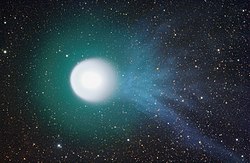Our website is made possible by displaying online advertisements to our visitors.
Please consider supporting us by disabling your ad blocker.
Comet Holmes
 Comet 17P/Holmes and its blue ion tail (taken on November 4, 2007) | |
| Discovery | |
|---|---|
| Discovery date | November 6, 1892 |
| Designations | |
| 1892 V1; 1892 III; 1892f; 1899 L1; 1899 II; 1899d; 1906 III; 1906f; 1964 O1; 1964 X; 1964i; 1972 I; 1971b; 1979 IV; 1979f; 1986 V; 1986f; 1993 VII; 1993i | |
| Orbital characteristics | |
| Epoch | October 27, 2007 (JD 2454400.5) |
| Aphelion | 5.183610 AU |
| Perihelion | 2.053218 AU |
| Semi-major axis | 3.618414 AU |
| Eccentricity | 0.432564 |
| Orbital period | 6.882994 a |
| Inclination | 19.1126° |
| Last perihelion | February 19, 2021[1][2] March 27, 2014 May 4, 2007 |
| Next perihelion | January 31, 2028[3][4] |
Comet Holmes /ˈhoʊmz/ (official designation: 17P/Holmes) is a periodic comet in the Solar System, discovered by the British amateur astronomer Edwin Holmes on November 6, 1892. Although normally a very faint object, Holmes became notable during its October 2007 return when it temporarily brightened by a factor of a million, in what was the largest known outburst by a comet, and became visible to the naked eye.[5] It also briefly became the largest object in the Solar System, as its coma (the thin dissipating dust ball around the comet) expanded to a diameter greater than that of the Sun (although its mass remained minuscule).[6] Between 1857–2106 perihelion remains between 2.05–2.36 AU.[7]
- ^ Seiichi Yoshida. "17P/Holmes". Seiichi Yoshida's Comet Catalog. Retrieved 2010-02-24.
- ^ Syuichi Nakano (2011-05-19). "17P/Holmes (NK 2100)". OAA Computing and Minor Planet Sections. Archived from the original on 2015-09-11. Retrieved 2012-02-18.
- ^ "17P/Holmes Orbit". Minor Planet Center. Retrieved 2021-06-12.
- ^ "Horizons Batch for 17P/Holmes (90000285) on 2028-Jan-31" (Perihelion occurs when rdot flips from negative to positive). JPL Horizons. Retrieved 2023-02-11. (JPL#K212/32 Soln.date: 2023-Jan-30)
- ^ Gritsevich, M.; Nissinen, M.; Oksanen, A.; Suomela, J.; Silber, E. A. (June 2022). "Evolution of the dust trail of comet 17P/Holmes". Monthly Notices of the Royal Astronomical Society. 513 (2): 2201–2214. doi:10.1093/mnras/stac822. hdl:10995/117894.
- ^ Jewitt, David (2007-11-09). "Comet Holmes Bigger Than The Sun". Institute for Astronomy at the University of Hawaii. Retrieved 2007-11-17.
- ^ Kinoshita, Kazuo (2019-05-22). "17P/Holmes past, present and future orbital elements". Comet Orbit. Archived from the original on 2011-07-10. Retrieved 2023-07-19.
Previous Page Next Page


